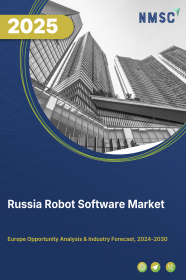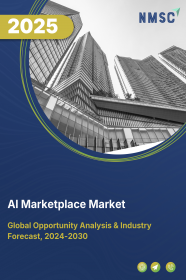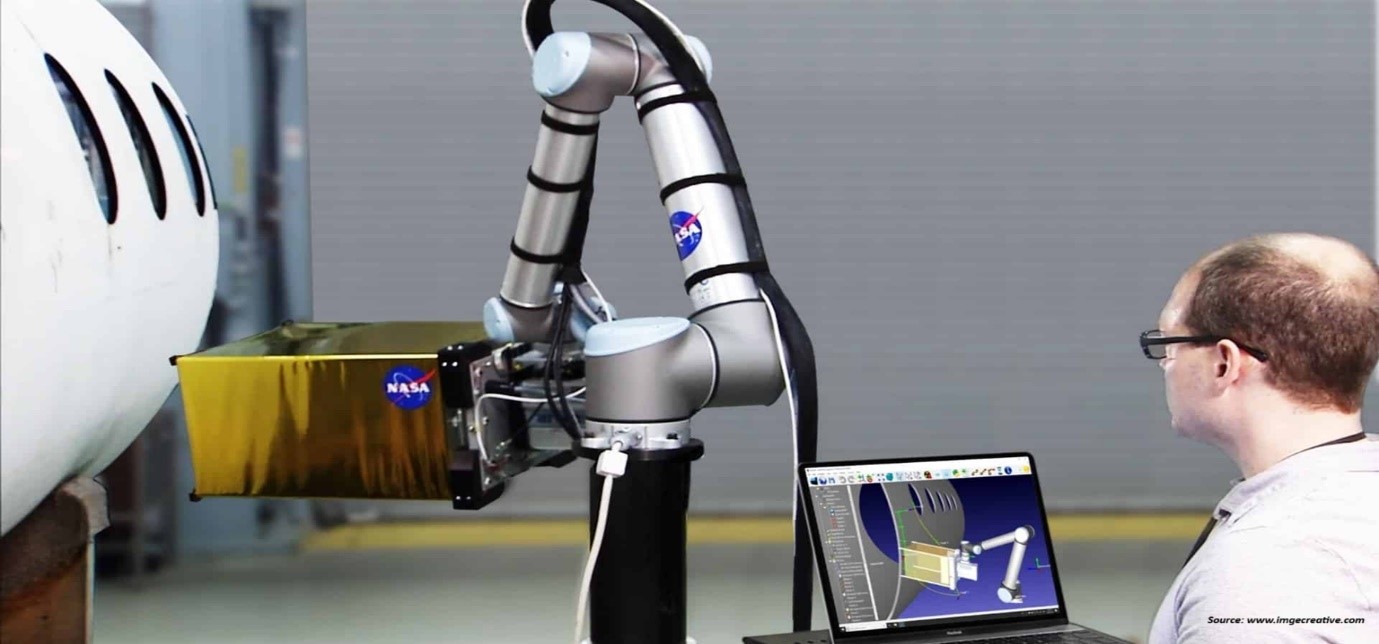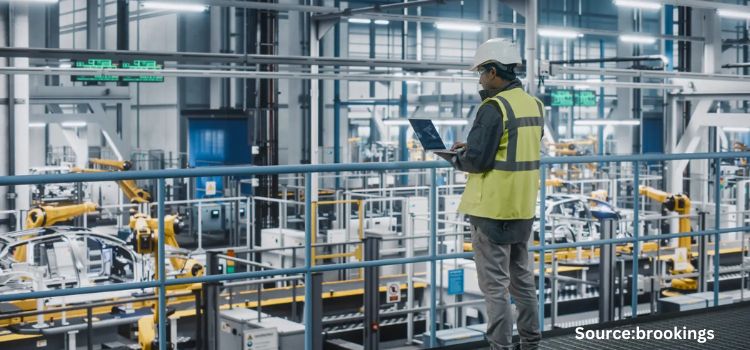
Russia Robot Software Market by Software Type (Recognition Software, Simulation Software, Predictive Maintenance Software, Communication Management Software, and Data Management and Analysis Software), by Robot Type (Service Robots and Industrial Robots), by Deployment Mode (On-premise and On-demand), by Organization Size (Large Enterprises and Small and Medium-sized Enterprises (SMEs) – Opportunity Analysis and Industry Forecast, 2024–2030
Industry: ICT & Media | Publish Date: 14-Feb-2025 | No of Pages: 126 | No. of Tables: 92 | No. of Figures: 57 | Format: PDF | Report Code : IC2384
US Tariff Impact on Russia Robot Software Market
Trump Tariffs Are Reshaping Global Business
Russia Robot Software Market Overview
The Russia Robot Software Market size was valued at USD 230.9 million in 2023, and is expected to reach USD 1021.8 million by 2030, with a CAGR of 22.7% from 2024 to 2030. Robot software comprises a suite of programs and algorithms tailored to supervise and manage the operations of robots or robotic systems across various industries, including logistics, manufacturing, entertainment, healthcare, and more. Its functionality encompasses several crucial components.
Firstly, it coordinates and manages the movements and behaviors of robots, ensuring precise and efficient task execution by issuing detailed commands to robotic components such as motors and actuators. Additionally, robot software plays a critical role in interpreting data from various sensors embedded within robots, including cameras, Light Detection and Ranging (LIDAR) sensors, and tactile sensors. This data interpretation provides essential environmental feedback that enables robots to accurately perceive and understand their surroundings.
An integral aspect of robot software is its ability to make intelligent decisions using artificial intelligence (AI) and machine learning (ML) algorithms. Through the analysis of data from sensors, adherence to predefined rules, or learning from past experiences, robots can adapt to changing conditions, allowing them to operate autonomously and adjust their actions in real-time. Furthermore, robot software facilitates communication and networking among robots, enabling collaboration for complex tasks or data exchange with a central control system. This interconnectedness facilitates synchronized operations in industrial environments, leading to enhanced efficiency and productivity.
Growing Focus on Safety and Compliance Propels the Russia Robot Software Market
The increasing focus on safety and compliance serves as a significant catalyst driving the growth of the Russia robot software market. With growing concerns surrounding workplace safety and regulatory adherence, organizations prioritize the adoption of robot software solutions that guarantee the safe and compliant operation of robotic systems.
Robot software plays a pivotal role in implementing essential safety features, risk assessment tools, and compliance frameworks, thereby minimizing the risk of accidents and ensuring conformity with industry regulations and standards.
Moreover, as the regulatory landscape evolves and becomes more rigorous, there is a heightened demand for robot software capable of facilitating real-time monitoring, reporting, and documentation of safety and compliance metrics. By effectively addressing these concerns and offering robust solutions for safe and compliant operations, the increasing focus on safety and compliance fuels the adoption of robot software across various industries, thereby stimulating Russia robot software market growth.
Increasing Investments in Research and Development (R&D) Drive the Growth of the Russia Robot Software Market
Increasing investments in research and development (R&D) are pivotal in propelling the growth of the Russia robot software market. With organizations and governments allocating more resources to R&D initiatives, there is a heightened emphasis on advancing robotics and automation technologies, including robot software.
These investments serve as catalysts for innovation, resulting in the development of more sophisticated and capable robot software solutions. R&D endeavors contribute significantly to enhancing functionalities such as AI integration, machine learning algorithms, and advanced control systems, thereby enabling robots to perform complex tasks with increased efficiency and autonomy.
Additionally, R&D investments facilitate the exploration of new applications and use cases for robot software across diverse industries, thereby expanding the market's potential. By fostering technological advancements and addressing emerging challenges, heightened R&D investments stimulate market growth and drive the evolution of the robot software market.
High Initial Investment for Acquiring Robot Hardware Restrain the Growth of the Russia Market
The considerable upfront investment required to acquire robot hardware poses a significant challenge to market growth. Procuring robot hardware entails substantial initial costs, including the purchase of robotic systems, peripherals, and associated equipment.
These expenses can be prohibitive for many organizations, especially small and medium-sized enterprises (SMEs) or those with constrained budgets. The substantial financial commitment required for robot hardware may deter potential adopters from investing in robot software solutions, despite recognizing their potential long-term benefits.
Moreover, the high initial investment could prolong the return on investment (ROI) period, leading to longer payback periods and constraining the scalability of robot deployments. Hence, addressing the challenge of high initial investment costs for robot hardware is crucial to facilitating broader adoption and driving Russia robot software market growth.
Development of Digital Twins and Simulation Software Creates New Opportunities in the Russia Market
The rise of digital twins and simulation software creates fresh trends in the Russia robot software market by providing advanced tools for modeling, testing, and optimizing robotic systems in the country. Digital twins generate virtual replicas of physical robots and their surroundings, facilitating real-time monitoring, analysis, and predictive maintenance.
Simulation software enables users to simulate different scenarios and environments, validating robot software algorithms and enhancing performance before deployment. These technologies offer notable benefits, including reduced development time and costs, improved scalability, and enhanced risk management.
Moreover, digital twins and simulation software facilitate collaborative development and training, enabling stakeholders to iterate and refine robot software solutions more efficiently. By furnishing robust tools for design, testing, and optimization, the rise of digital twins and simulation software drives innovation and expedites the adoption of robot software across various industries.
Competitive Landscape
Several key players operating in the Russia robot software industry include IBM, NVIDIA, ABB Ltd., FANUC, Teradyne, Inc., H2O.ai, Brain Corp, CloudMinds, Clearpath Robotics, and Neurala, Inc. These market players are adopting strategies to maintain their dominance in the market.
Russia Robot Software Market Key Segments
By Software Type
-
Recognition Software
-
Simulation Software
-
Predictive Maintenance Software
-
Communication Management Software
-
Data Management and Analysis Software
By Robot Type
-
Service Robots
-
Ground
-
Aerial
-
Underwater
-
-
Industrial Robots
-
Traditional Industrial Robots
-
Articulated Robots
-
SCARA Robots
-
Parallel Robots
-
Cartesian Robots
-
Other Robots
-
-
Collaborative Industrial Robots
-
By Deployment Mode
-
On-premise
-
On-demand
By Organization Size
-
Large Enterprises
-
Small and Medium-sized Enterprises (SMEs)
By Industry Vertical
-
Banking, Financial Services, and Insurance (BFSI)
-
Automotive
-
Retail and eCommerce
-
Aerospace & Defense
-
Healthcare and Life Sciences
-
Transportation and Logistics
-
Manufacturing
-
Telecommunications and IT
-
Academia and Research
-
Media & Entertainment
-
Others
REPORT SCOPE AND SEGMENTATION:
|
Parameters |
Details |
|
Market Size in 2023 |
USD 230.9 Million |
|
Revenue Forecast in 2030 |
USD 1021.8 Million |
|
Growth Rate |
CAGR of 22.7% from 2024 to 2030 |
|
Analysis Period |
2023–2030 |
|
Base Year Considered |
2023 |
|
Forecast Period |
2024–2030 |
|
Market Size Estimation |
Million (USD) |
|
Growth Factors |
|
|
Companies Profiled |
10 |
|
Market Share |
Available for 10 companies |
|
Customization Scope |
Free customization (equivalent up to 80 working hours of analysts) after purchase. Addition or alteration to country, regional, and segment scope. |
|
Pricing and Purchase Options |
Avail customized purchase options to meet your exact research needs. |
KEY PLAYERS
-
IBM
-
NVIDIA
-
ABB Ltd.
-
FANUC
-
Teradyne, Inc.
-
H2O.ai
-
Brain Corp
-
CloudMinds
-
Clearpath Robotics
-
Neurala, Inc.

















 Speak to Our Analyst
Speak to Our Analyst





















